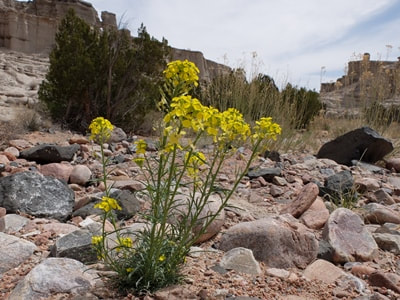|
Found in sandy, rocky soil from the desert to alpine meadows
Seen blooming in April in Plaza Blanca The Wallflower is a common and widespread species. It earned its common name by growing on stone walls in Europe. It grows from a few inches to 30" high with a dense cluster of flowers on an erect stem. Flowers are most typically bright golden yellow but plants in some populations may have tangerine-colored, pink or purple flowers. Each flower has four flat petals and is more than ½ inch across. Seed pods are up to 4 inches long and grow upright, parallel to the stem. In Greek, Erysimum translates as “to help or save” in reference to the medicinal qualities of several species. Practitioners of European folk medicine used wallflower poultices to relieve bronchial congestion, as did Native Americans, who also used dried leaves or seeds to make a tea for stomach cramps and ground the flowers to make yellow paint. Wallflowers are also important sources of food for wildlife, including the caterpillars of a number of butterfly and moth species. Source. If you trying to identify a different flower then you can check what other flowers bloom this month. If you cannot identify a flower from the website, send a photo and where you took it to [email protected]. Read online for tips.
0 Comments
Leave a Reply. |
AuthorI am Marilyn Phillips, a native of England, whose love of nature and the outdoors from childhood brought me by a circuitous route to Crested Butte, Colorado in 1993 and 16 years later to northern New Mexico. My exploration of the many trails in these areas, my interest in wildflowers and photography, and career in computer system design came together in this creation. If you have any corrections, comments or questions, please contact me by email. Archives
September 2025
Categoriescopyright © 2020
|



 RSS Feed
RSS Feed